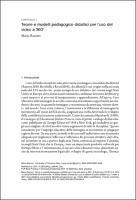Chapter Teorie e modelli pedagogico-didattici per l’uso del video a 360°
| dc.contributor.author | Ranieri, Maria | |
| dc.date.accessioned | 2022-12-22T16:06:49Z | |
| dc.date.available | 2022-12-22T16:06:49Z | |
| dc.date.issued | 2022 | |
| dc.identifier | ONIX_20221222_9788855186469_56 | |
| dc.identifier.issn | 2704-5919 | |
| dc.identifier.uri | https://library.oapen.org/handle/20.500.12657/60394 | |
| dc.language | Italian | |
| dc.relation.ispartofseries | Studi e saggi | |
| dc.subject.classification | thema EDItEUR::J Society and Social Sciences::JN Education | en_US |
| dc.subject.other | pedagogical affordances of 360° video | |
| dc.subject.other | situated learning | |
| dc.subject.other | experiential learning | |
| dc.subject.other | transformative learning | |
| dc.subject.other | educational scenarios | |
| dc.title | Chapter Teorie e modelli pedagogico-didattici per l’uso del video a 360° | |
| dc.type | chapter | |
| oapen.abstract.otherlanguage | The chapter focuses on the learning theories (situated learning, experiential learning, transformative learning) that can allow one to highlight the pedagogical affordances of the 360° video, paying a particular attention to the Higher Education context and also offering an overview of possible educational scenarios based on the use of 360° video. In addition, it examines the main benefits and barriers of 360° video in the educational field. | |
| oapen.identifier.doi | 10.36253/978-88-5518-646-9.04 | |
| oapen.relation.isPublishedBy | bf65d21a-78e5-4ba2-983a-dbfa90962870 | |
| oapen.relation.isbn | 9788855186469 | |
| oapen.series.number | 241 | |
| oapen.pages | 11 | |
| oapen.place.publication | Florence |

